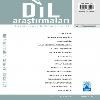Tuva Türkçesinde {+KI} Aitlik Eki: Eski Türkçe Ve Türkiye Türkçesi İle Karşılaştırmalı Bir İnceleme
Bu çalışmada, Güney Sibirya Türk lehçelerinden Tuva Türkçesinde {+KI} ekinin kullanımı üzerine, Eski Türkçe ve Türkiye Türkçesi ile karşılaştırmalı bir inceleme yapılmıştır. Türkçede genellikle aitlik eki olarak adlandırılan {+KI} eki, Türk dilinin yaygın ve işlek eklerinden biridir. Ekin temel fonksiyonu; bulunma, temsil, aitlik gibi anlamlarla sıfat veya zamir görevli unsurlar türetmektir. Ek, Eski Türkçeden beri kendine özgü kullanım özellikleriyle dikkat çeker. Yer ve zaman bildiren isim soylu sözcüklere doğrudan eklenebildiği gibi, bazı hâl eklerini almış sözcüklerden sonra da işlek olarak kullanılır; bu yönüyle yapım eki ile çekim eki arasında bir yerde konumlanır. Bu özellikleri nedeniyle söz konusu ekin diğer ekler arasındaki yeri de kaynaklarda tartışılmıştır. Ekin kullanımları, tarihî veya çağdaş lehçeler arasında benzer ve farklı yönlere sahiptir. Bu nedenle eldeki inceleme karşılaştırmalı olarak yapılmıştır. Ekin Tuva Türkçesindeki art zamanlı gelişimini göstermek amacıyla Eski Türkçeyle; incelenen özelliklerin Türkiye Türkçesindeki karşılıklarını göstermek açısından da Türkiye Türkçesiyle karşılaştırma yoluna gidilmiştir. Ekin Tuva Türkçesindeki genel özelliklerine konuyla ilgili kaynaklarda yer verildiği ancak üzerinde durulmayan yönlerin de olduğu görülmüştür. Bu incelemede ekin kullanım özelliklerinin çeşitli açılardan bir bütün hâlinde gösterilmesi ve özellikle Tuva Türkçesine özgü yanların karşılaştırmalı olarak ortaya çıkarılması amaçlanmaktadır. İnceleme; ekin fonetik özellikleri, kullanılış şekilleri ve işlevleri, eki alan sözcüklerin sözlükselleşme durumları ve ekin morfo-sentaktik özellikleri ana başlıkları altında yapılmıştır. İncelemeyle ilgili genel sonuçlar şu şekildedir: Aitlik eki almış sözcükler Tuva Türkçesinde sözlükselleşme bakımından daha ileri seviyededir. Türkiye Türkçesinde ek, geçici ilişkiler kurmak üzere işlek olarak kullanılırken Tuva Türkçesinde daha çok kalıplaşmış olarak varlık göstermektedir. Aitlik ekinin Türk dilinde yaygın bir özelliği, bulunma hâli ekinden sonra da işlek olarak kullanılmasıdır ancak Tuva Türkçesinde bu kullanım işlek değildir. İncelemede bunun sebepleri tahlil edilmiştir. Ek, Tuva Türkçesinde; sıra sayıları yapmak, başka birleşik ekler meydana getirmek gibi ilave gramerlik özellikler de kazanmıştır.
Anahtar Kelimeler:
{+KI} eki, aitlik eki, Tuva Türkçesi, Eski Türkçe, Türkiye Türkçesi, morfoloji, the suffix {+KI}, relative suffix/possessive suffix, Tuvan, Old Turkic, Turkish, morphology
The Relative Suffix {+KI} In Tuvan: A Comparative Study With Old Turkic And Turkish
In this study, a comparative analysis has been made on the use of the suffix {+KI} in Tuvan, one of the South Siberian Turkic languages, with Old Turkic and Turkish. The suffix {+KI}, which is named as mixed suffix, pronominal suffix, relative suffix, possessive pronoun etc. in the sources, is one of the productive and common suffixes of Turkic. The main function of the suffix is to create the words in the function of adjective or pronoun from nominals with the meanings of presence, representation, possession. The suffix draws attention with its unique usage features since Old Turkic. It can be both used after nominals in the meaning of time or location and after the nominals marked by case suffixes and from this aspect it stands between formatives and inflectional suffixes. Because of these usage features the place of this suffix among other suffixes is discussed in the sources. The uses of the suffix among historical or contemporary Turkic languages have similar and different aspects. For this reason, this analysis has been made comparatively. In order to show the diachronic development of the suffix in Tuvan, a comparison was made with Old Turkic and in order to show the equivalents of the examined features in Turkish, a comparison was made with Turkish. The general features of the suffix in Tuvan are included in the sources but it has been seen that there are some aspects that are not emphasized. In this study, it is aimed to show the usage features of the suffix as a whole from various aspects and to reveal the features specific to Tuvan comparatively. The study is made under the following headings: the phonetic features of the suffix, usage/affixation features and functions of the suffix, the lexicalization status of the words marked by this suffix and its morpho-syntactic features. The general results of the examination are as follows: The words marked with this suffix are at a more advanced stage in Tuvan in terms of lexicalization. While the suffix is usued productively and provide temporary relations between nominals in Turkish, it is used generally in formulaic constructions in Tuvan. A common feature of this suffix in Turkic is to be used after locative suffix productively but this usage is not productive in Tuvan. In the study, the reasons for this are analyzed. In Tuvan, the suffix {+KI} shows additional grammatical features such as forming ordinal numbers and creating other compound suffixes.
Keywords:
the suffix {+KI}, relative suffix/possessive suffix, Tuvan, Old Turkic, Turkish, morphology,
___
- ALYILMAZ, Cengiz (1994). Orhun Yazıtlarının Söz Dizimi. Erzurum: Atatürk Üniversitesi.
- ALYILMAZ, Cengiz (2021). Bilge Tonyukuk Yazıtları. Ankara: Türk Dil Kurumu.
- ANDERSON, Gregory David; Harrison, K. David (1999). Tyvan. München: LINCOM Europa.
- ARGUNŞAH, Mustafa (2018). Çağatay Türkçesi. İstanbul: Kesit.
- ARIKOĞLU, Ekrem (2007a). "Hakas Türkçesi". Türk Lehçeleri Grameri (Edt. Ahmet Bican Ercilasun). Ankara: Akçağ, 1085-1148.
- ARIKOĞLU, Ekrem (2007b). "Tuva Türkçesi". Türk Lehçeleri Grameri (Edt. Ahmet Bican Ercilasun). Ankara: Akçağ, 1149-1228.
- ISSN: 1307-7821
- Yayın Aralığı: Yılda 2 Sayı
- Başlangıç: 2007
- Yayıncı: Avrasya Yazarlar Birliği
Sayıdaki Diğer Makaleler
13. Yüzyıl Doğu Türkçesiyle Yazılmış Bir Kur’ân Risalesi
Maytrısimit’te Anlamsal / Sözlüksel Dil Ögelerinden Yabancı Adlar
Ermeni-Kıpçak Dilinin Tarihî Evreleri
Altun Yaruk Sudur Metninde Sadece İkileme Yapısında Görülen Fiiller Üzerine
Salihli Kazak Türklerinin Atasözleri Üzerine Metaforik Bir İnceleme: Hayvan Metaforları
Televizyon Dizilerinde Yabancı Kelime ve Dil Bilgisi Ögelerinin Kullanımı
Türkçede Söylem Belirleyici Olarak Soru Yapılı İfadeler
Die Alttürkische Xuanzang-Biographie IV
